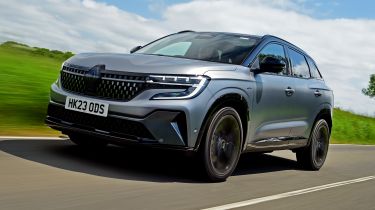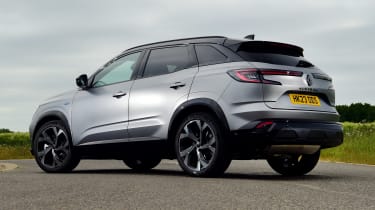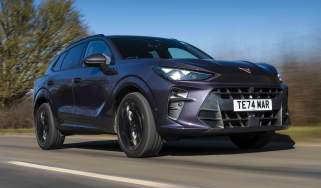New Renault Austral 2023 review
The Austral is a strong effort from Renault, but it’s unlikely to dominate the ultra-competitive family SUV market

Verdict
Renault's new Austral family SUV is defined by its tech. The bang-up-to-date infotainment works really well, which will be enough to win sales on some fronts, while the level of kit on offer for the monthly outlay is certainly competitive. However, practicality is acceptable rather than class-leading and the way the Austral drives – its ride in particular – means it's just a little behind those at the sharp end of the sector. It's a strong effort from Renault that moves its offering on from the Kadjar, but this area of the market is ultra-competitive and there are some very talented rivals in it.
The Austral is a vitally important car for Renault. However, as a follow up to its successful Kadjar family SUV, you could say that the French brand is facing the equivalent of the music industry's 'difficult second album'.
That's because it's launching in a sector where competitiveness has grown exponentially, there are the Peugeot 3008 and Skoda Kodiaq to think about, while the Hyundai Tucson (Renault's number one benchmark during the development of the Austral, incidentally), Kia Sportage, Nissan Qashqai, Ford Kuga and Toyota RAV4 all come with full hybrid power.
So does the Austral, incidentally. In fact, it's the only powertrain available in this new model, with the sharp-looking SUV featuring a 1.2-litre three-cylinder turbocharged petrol engine supplemented by a small 1.7kWh battery feeding an electric motor for a total of 197bhp.
This E-Tech 200 powertrain allows for up to 80 per cent of city driving to be completed on electricity alone, Renault claims, and delivers “class-leading efficiency”, with up to 60.1mpg possible and CO2 emissions from as low as 105g/km. So far, so good, then.
The tech story is equally compelling, as all UK cars feature matrix LED headlights, a 9.3-inch head-up display, a 12.3-inch digital dash and a 12-inch touchscreen that runs Google-powered infotainment.
This works superbly, with the voice control offering the usual intuitive level of integration we've come to expect from systems from the software giant – you can even control items in your home from your car using voice control. The graphics are sharp and the interface looks nice in areas where the Google link is obvious (mainly the mapping on both the main display and the digital dash), while the Renault menus look and work slicker than anything we've experienced from the brand yet. Thank the Google-powered back end and speedy Qualcomm Snapdragon processor for that.
Prices start from £36,995 for the entry-level techno model, which also features 19-inch alloy wheels, and an eight-speaker stereo. While this lead-in price might seem steeper than some rivals, Renault has pushed the Austral's positioning towards the more premium end of the market, so it'll also take on the new VW Tiguan when that breaks cover later this year.
However, in this class the majority of buyers choose PCP finance deals, so with strong predicted residual values plus a £500 deposit contribution on this base-spec car, with a £6,146 deposit on a four-year deal limited to 6,000 miles per year, a monthly price of £349 seems fair.
This rises to £374 a month with a £750 contribution for the mid-spec – and predicted best-seller – techno esprit Alpine trim (£36,995 cash price), which features 20-inch alloy wheels and a special body kit that evokes the look of the Megane E-Tech Electric, heated front seats and a heated steering wheel, electrically adjustable seats with massage functionality, adaptive cruise control and a powered tailgate.
Top-spec iconic esprit Alpine models feature the same look with wireless phone charging, a panoramic roof, a 360-degree camera, an upgraded Harmon Kardon stereo and 4Control rear-axle steering on top for £409 a month (Renault's deposit contribution rises to £1,000) on the same terms – or £39,495 if you'll pay cash.
On the move the Austral's powertrain is refined. The electric motor delivers a solid supplemental burst of torque low down to help with performance from a standstill and on light throttle the car often defaults to EV mode, making for relaxed progress. This continues when the petrol unit fires up as the engine note is subdued even under hard acceleration. It's not as noisy or as droney as a Qashqai e-Power or RAV4, for example.
However, when you do even ask for moderate acceleration there's sometimes a noticeable hesitation as the car works out how to best use its two power sources. This manifests itself as a pause in acceleration, which could come as a surprise if you're going for an overtake.
While the adjustable levels of regenerative braking is a good feature – and unusual for a hybrid, with the top setting offering more retardation than we expected – the result is not always consistent, including pedal feel, with the brake pedal sometimes feeling firm under your foot, sometimes soft. It moves physically too.
Performance is still solid though, with a 0-62mph time of 8.4 seconds, but the Austral's set-up has been designed with a relaxed driving style in mind to maximise the efficiency of its petrol-electric propulsion.
It's a shame, then, that the ride is choppy on 20-inch wheels. Body control is nothing more than ok, but over the kind of broken B-roads you find all across Britain the suspension struggles to filter out the worst of the bumps, so the Austral's chassis bobbles along at town and suburban speeds.
It seems a little better on the motorway with more speed and energy, but expansion joints and ridges still cause a sharper reaction than we'd like from both axles.
The 4Control rear-axle steering is a plus though. The steering weight is light, but combined with the rear wheels turning in the opposite direction at low speeds it means the Austral feels nicely manoeuvrable. The car's turning circle is tighter than a Clio's, at 10.1 metres.
On more flowing roads agility is good, with the light steering helping deliver a fairly flickable feel, but it's still far from sporty, which means the mixed ride on large wheels is even more of an issue as there's little gained elsewhere for this trait.
Practicality is good though. There's plenty of space in the rear even with a panoramic roof (although space to tuck your feet under the seat in front is a little tight), while a 555-litre boot means the Austral should be able to cut it when it comes to the pressures and practicality needs of family life. It's worth noting that the car's 12-volt battery beneath the boot floor eats into space, however.
At least storage inside is good. The door bins are a good size, there are two cup-holders below the main screen, a deep storage compartment beneath the sliding handle that doubles as a rest for your hand when using the touchscreen, plus another large lidded cubby behind this.
Some of the materials lower down in the cabin are on the solid side, but the Austral's trim in this area is no worse than many in the class, plus some nice, soft material inserts on the dash and real metal finishers just about help to justify its more premium price tag. However, cheap air vents shatter the illusion that this is a true premium player.
| Model: | Renault Austral E-Tech iconic esprit Alpine |
| Price: | £39,495 |
| Engine: | 1.2-litre 3cyl turbo petrol hybrid |
| Power/torque: | 197bhp/205Nm |
| Transmission: | Multi-modal clutchless automatic, front-wheel drive |
| 0-62mph: | 8.4 seconds |
| Top speed: | 108mph |
| Economy/CO2: | 57.7mpg/110g/km |
| On sale: | Now |














